L-class: Difference between revisions
Pbcjohnston (talk | contribs) mNo edit summary |
|||
| (100 intermediate revisions by 2 users not shown) | |||
| Line 1: | Line 1: | ||
{{#seo:|title=U.S. Navy L-class submarine - PigBoats.COM|title_mode=replace|keywords=US L-class submarine}} | |||
{{#seo:|description=Notes, photographs, and pictures of the U.S. Navy's L-class submarines.}} | |||
[[File:New Header L-class.jpg]] | |||
[[File: | |||
< | === <big>Design and Construction Notes</big> === | ||
<div style="text-align: justify;"><span style="color:#00008B">The L-class coastal submarines were built to two distinctly different designs at four different shipyards. The two designs were from the Electric Boat Company (EB) of New York City (later Groton, CT.) and the Lake Torpedo Boat Company (LTB) of Bridgeport, CT. The L-1 through L-4, and L-9 through L-11 were of the EB design and were built at an EB subcontractor, the Fore River Shipbuilding Co. of Quincy, MA. The Fiscal Year 1913 appropriations that paid for these boats also brought Simon Lake back into the submarine construction chain. The FY-10, 11, and 12 appropriations had given him only one submarine, FY-10's [[G-3|'''G-3''']]. This was mostly because of his very fragile financial situation and because he was struggling to complete and deliver the [[G-class|'''G-class''']] boats that had earlier been assigned to him. Having cleared the G-class construction log jam and having reorganized his company, Lake was assigned L-5 through L-8, although only the L-5 was actually built at the Lake yard in Bridgeport, CT. Desirous of once again having submarines built on the west coast the Navy contract stipulated that at least two boats be built there. Lake sub-contracted the L-6 and L-7 to Craig Shipbuilding in Long Beach, CA. The Bureau of Construction & Repair also wanted to get into the construction business as a means of offsetting the near monopoly that Electric Boat had acquired, and as a way to keep the exasperating Simon Lake at bay. BuC&R officials went to Lake and purchased a license from him to build the L-8 to his design at the Portsmouth Navy Yard in Kittery, ME. L-8 was to be the first in a long line of future submarines to be built at government owned Navy Yards. | |||
While very similar in military and operational capability, the two designs were vastly different in installed equipment, interior arrangement, and external appearance. EB chose to use individual muzzle doors for the torpedo tubes as opposed to its standard rotating bow cap. The reason for this design deviation is unknown. They reverted to the bow cap for the subsequent N and O-classes. Lake had long standardized on individual muzzle doors. Lake mounted the propellers, stern diving planes, and the rudder ventrally below a flat, horizontal "shovel" shaped stern, which was actually more buoyant than the EB design. EB used their standard axial mounted rudder and stern plane arrangement and flank mounted propeller shafts seen in all their previous designs. | |||
Dividing up the interior of a submarine into separate watertight compartments went all the way back to the [[D-class|'''D-class''']] of 1909. However, those internal bulkheads were intended to control shallow water flooding only and were not rated to full submergence depth. The L-class introduced full strength bulkheads for the first time, a feature that submariners had long sought. EB used an internal bulkhead arrangement that would be familiar to later submariners; torpedo room at the bow, forward battery/berthing compartment, control room, after battery/messing compartment, and engine room. The Lake design was characteristically quite different. His forward battery was actually under an enlarged torpedo room, with the after battery under an enlarged control room. There was a separate tiller room all the way at the stern that housed the operating gear for the rudder; it was accessible only through a horizontal crawl tube that passed ''through'' an aft ballast tank. | |||
L-3, L-9, and L-11 eventually received Busch-Sulzer diesels removed from Lake designed N-boats in 1923. By that time the original NELSECO engines of those boats were worn out. The Busch-Sulzer engines were well liked by the Navy and thus the swap was a cost-effective way of fixing a problem. | |||
Significantly, the L-class boats were the first submarines in the U.S. Navy to be equipped with a deck gun. Spurred by intelligence reports of guns on European submarines, the L-class had a [http://www.navweaps.com/Weapons/WNUS_3-23_mk13.php '''3"/23 caliber Mk 9 gun'''] on the forward deck. This gun could be rotated vertically, then retracted down into a watertight tub that penetrated into the pressure hull. When retracted, the circular gun shield formed the top of the tub, keeping the breech end of the gun dry. A tampion in the muzzle kept the bore dry. Retracted, only the barrel stuck up above the deck, looking like a post. The early EB boats were built without the gun and had it added later. Some of the Lake boats had the gun removed after the war. | |||
[ | |||
The L-class made up the bulk of the submarines that the USN deployed to the European war zone during WWI. They operated out of the Azores and Bantry Bay, Ireland on anti U-boat patrols. While in the war zone off Ireland, the boats had the letter "A" painted on the fairwater directly adjacent to their name. This was intended to reduce confusion between the American boats and the [https://en.wikipedia.org/wiki/British_L-class_submarine '''Royal Navy's L-class submarines''']. Not much came of the immense effort that was needed to deploy the American boats overseas, as they had no confirmed sinkings of enemy submarines or ships. However, it did drive home the fact that American coastal submarines were too small, too short ranged, and possessed poor habitability for North Atlantic waters. The follow-on [[R-class|'''R-class''']] and [[S-class|'''S-class''']] would correct many of these deficiencies.</span></div> | |||
L- | |||
[[File:Red bar sub.jpg]] | |||
=== <big>L-1 (Submarine No. 40, later SS-40)</big> === | |||
==L- | [[File:L1-ussl11-01.jpg|left|500px|Photo from the Library of Congress Collection.]] | ||
<div style="text-align: justify;"><span style="color:#00008B">L-1 riding at anchor while on sea trials, March or April 1916, probably off Provincetown, Mass. A low-lying shore line with houses can be seen in the background, reminiscent of Cape Cod. The L-class were the first US submarines designed to carry a deck gun of any sort, in this case a 3"/23 caliber Mk 9 gun. But it wasn't until the L-9 that guns were installed during construction. The L-1 through L-8 were retrofitted later with the gun. As you can see the L-1 has no gun in this early photo.</span></div> | |||
[[L-1|See more L-1 photos]] | |||
[[File:Red bar sub.jpg]] | |||
=== <big>L-2 (Submarine No. 41, later SS-41)</big> === | |||
[[File:L 2.jpg|left|500px|U.S. Navy photo.]] | |||
<div style="text-align: justify;"><span style="color:#00008B">L-2 in an unknown location, approximately fall of 1916. In July of 1918 while patrolling in the Irish Sea, a large explosion rocked the L-2 about 25 feet on her beam. A torpedo aimed at her by a German U-boat had seemingly detonated prematurely. A periscope was sighted so the L-2 immediately submerged and made an unsuccessful attempt to ram the submarine. with her primitive sonar she couldn't track the U-boat well under water, plus the U-boat had superior under water speed. Later it was suspected that a U-boat had indeed attempted to fire upon the L-2, but another U-boat, the U-65, was unknowingly in the way and was hit by the torpedo meant for L-2. Some time later when the L-2 was dry docked her hull plating was noted to be heavily dented from the close by explosion. The U-65 never returned to her port.</span></div> | |||
[[L-2|See more L-2 photos]] | |||
[[File:Red bar sub.jpg]] | |||
==L- | === <big>L-3 (Submarine No. 42, later SS-42)</big> === | ||
[[File:L3.jpg|left|500px|National Archives photo.]] | |||
<div style="text-align: justify;"><span style="color:#00008B">L-3 with sailing yachts, early in her career, approximately 1916. The location is unknown, but could be Newport, R.I. Notice the complete lack of a bridge structure. It would be added later during the war.</span></div> | |||
[[L-3|See more L-3 photos]] | |||
[[File:Red bar sub.jpg]] | |||
=== <big>L-4 (Submarine No. 43, later SS-43)</big> === | |||
[[File:L-4 port side.jpg|left|500px|Photo NH 51138 courtesy of NHHC.]] | |||
<div style="text-align: justify;"><span style="color:#00008B">L-4 underway off Berehaven, Ireland, summer of 1918. She sports the original version of the "chariot" style bridge, a necessity in the rough waters of the Irish Sea and the eastern Atlantic. It greatly helped to protect the bridge watchstanders from weather while on the surface. It would later become a larger and permanent metal structure.</span> | |||
[[L-4|See more L-4 photos]] | |||
[[File:Red bar sub.jpg]] | |||
==L- | === <big>L-5 (Submarine No. 44, later SS-44)</big> === | ||
[[File:L-5-1a.jpg|left|300px|Photo in the private collection of Ric Hedman]] | |||
<div style="text-align: justify;"><span style="color:#00008B">This photo of L-5 was taken in the early fall of 1918, possibly in Bermuda. The boat is maneuvering alongside a pier, getting ready to tie up after a run at sea. Lines have been flaked out on deck and the two sailors on the bow seem to be ready to throw a "heevie", a small diameter line with a weight on the end. It is used to throw over to a pier or tender, so that the large, heavy mooring line can then be pulled over and secured. L-5 was a Lake design boat built at Lake's yard in Bridgeport, CT.</span></div> | |||
[[L-5|See more L-5 photos]] | |||
[[File:Red bar sub.jpg]] | |||
=== <big>L-6 (Submarine No. 45, later SS-45)</big> === | |||
[[File:L6.jpg|left|500px|National Archives photo.]] | |||
<div style="text-align: justify;"><span style="color:#00008B">The Lake design L-6 is shown under construction by the Craig Shipbuilding Company, Long Beach, CA., June 30, 1917. Note the circular flood port openings for the watertight superstructure, the open oval shaped torpedo loading hatch, and the very incomplete state of the conning tower fairwater. Although not yet in commission, there is a sailor standing watch on the forward deck with a rifle.</span> | |||
[[L-6|See more L-6 photos]] | |||
[[ | |||
[[File:Red bar sub.jpg]] | |||
< | === <big>L-7 (Submarine No. 46, later SS-46)</big> === | ||
[[File:L 7.jpg|left|500px|Photo from the private collection of Ric Hedman]] | |||
<div style="text-align: justify;"><span style="color:#00008B">L-7 with her crew on deck, alongside a submarine tender, most likely the [https://www.navsource.org/archives/09/36/3604.htm '''USS Alert (Submarine Tender #4)''']. The location is unknown, but is likely Mare Island Navy Yard. The date is approximately 1918-1919.</span> | |||
[[L-7|See more L-7 photos]] | |||
[[File:Red bar sub.jpg]] | |||
< | === <big>L-8 (Submarine No. 48, later SS-48)</big> === | ||
[[File:L-8-1.jpg|left|500px|Photo contributed by Clifford Chapski. His grandfather, Alfred G. Benjamin, took this photo while serving aboard the USS Charles Whittemore.]] | |||
<div style="text-align: justify;"><span style="color:#00008B">L-8 seen from the deck of the [https://www.navsource.org/archives/12/173232.htm '''USS Charles Whittemore'''], fall 1918 in the eastern Atlantic during an anti U-boat patrol. The Whittemore was acting as a decoy, and the L-8 would lay in wait for a U-boat to appear. They were unsuccessful in their efforts as the U-boats had become wary of decoy ships and would not approach.</span> | |||
[[L-8|See more L-8 photos]] | |||
[[File:Red bar sub.jpg]] | |||
=== <big>L-9 (Submarine No. 49, later SS-49)</big> === | |||
[[File:L-9 trials port side.jpg|left|500px|Photo NH 63383 courtesy NHHC.]] | |||
<div style="text-align: justify;"><span style="color:#00008B">L-9 while running builder's trials on the measured mile off Provincetown, MA. in Cape Cod Bay, spring of 1916. Note that while essentially complete at this point she still has a temporary canvas bridge structure. This would later be replaced with a permanent steel bridge fairwater.</span> | |||
[[L-9|See more L-9 photos]] | |||
[[File:Red bar sub.jpg]] | |||
< | === <big>L-10 (Submarine No. 50, later SS-50)</big> === | ||
[[File:L-10 Bantry Bay.jpg|left|500px|Library of Congress Collection.]] | |||
<div style="text-align: justify;"><span style="color:#00008B">The USS L-10, with the American “A” added to her fairwater to avoid confusion with the British L-class submarines, in Bantry Bay, Ireland. There is no date on the photo but the assumption is circa 1918. The L-10 was one of the best American subs working out of Ireland. | |||
LT Vincent Arthur Clarke, Jr. was sent for submarine training at New London, Connecticut. Upon graduation he was assigned to submarine duty and sent to the Azores. From there he was made the commanding officer of the L-10, probably relieving LT Newbold T. Lawrence Jr. as CO. The L-10 operated out of Bantry Bay, Ireland for the duration of the war. | |||
This command garnered Clarke a Navy Cross for his persistence in making the L-10 one of the "hot running boats" in WW I, racking up over 1700 hours out on patrol in pursuit of the enemy. War patrols in WW I were only an average of 10 days duration due to the sub's limits on food, water and fuel. | |||
LT Clarke is probably the officer on the bridge in this photo as the L-10 backs away from her mooring. The crew look to be stowing the mooring lines in preparation for possibly heading out on a war patrol looking for German submarines.</span> | |||
[[L-10|See more L-10 photos]] | |||
[[File:Red bar sub.jpg]] | |||
<div style="text-align: justify;"><span style="color:#000000"> | |||
=== <big>L-11 (Submarine No. 51, later SS-51)</big> === | |||
</div> | |||
[[File:L-11 from port on trials.jpg|left|500px|Photo NH 51173 courtesy NHHC.]] | |||
<div style="text-align: justify;"><span style="color:#00008B">L-11 running builder's trials in Cape Cod Bay off Provincetown, MA., summer of 1916. She still has a pipe frame and canvas bridge structure. Most likely the boat is running at her full speed of 14 knots, testing the upper range of engine power.</span> | |||
[[L-11|See more L-11 photos]] | |||
[[File:Red bar sub.jpg]] | |||
<div style="text-align: justify;"><span style="color:#000000"> | |||
=== <big>General L-class & group photos</big> === | |||
</div> | |||
[[File:2 L-Boats w-tender.jpg|left|500px|Photo in the private collection of Ric Hedman.]] | |||
<div style="text-align: justify;"><span style="color:#00008B">Here we have here two unidentified EB design L-class submarines. The unique shape of the bow planes pivot housings and the unique shaped “bullnose” on the tip of the bow are identifiers of the EB design for this class. The two flat rectangular covers, one on top of the other over the bow planes pivots can be seen. This cover was unique to the L-1, L-2, L-3 and L-4 and then again with the L-9, L-10, and the L-11. Submarines L-5 through L-8 were built to the Lake Co. design and did not have these pivot covers. This variant of the L-class of submarine were commissioned by late 1916. The L-6 thru L-8 variant were commissioned in 1917. L-5 was commissioned in 1918. | |||
Both submarines have a tall forward radio mast. In looking in other archives we have seen only the L-1 with such a mast. So, possibly one of these two vessels could be the L-1 but it could just be coincidence that there only exists one image, other than this one, with these masts. Radio was new and trials were being made all the time. | |||
Neither submarine have any sign of having SC tube listening gear installed at this point. So, a possible date is closer to commissioning, perhaps a late 1916 or early 1917. But for sure this is before the U.S. entered WW I on April 6, 1917. The submarines still are using the old-fashioned pre-war canvas bridge shelters that proved too flimsy to withstand the pressures of diving with it erected. They were too time consuming to try and take down in actual war time conditions. | |||
The British, having been at war with Germany for two years, taught their American cousins a lot of practical things about actual submarine warfare including the development and use of the metal chariot bridge surround that could remain in place while diving and withstand those pressures. Soon almost all U.S. submarines had this revision installed. | |||
Once these subs reached Europe, the British, to avoid confusing their L-class submarines with the American L-class, required the Americans to paint an "A" in front of their numbers. All combatants still wore hull identification at this time. In later conflicts all ID was painted out so an enemy could not keep track of sub movements, this is even done to this day. | |||
These two submarines are moored to a monitor-type tender that is also not identified but could possibly be the USS Tonopah (BM-8). Three sailors are standing on the tender's deck. There also seem to be at least two people each on the submarine's decks.</span></div> | |||
[[General L-boat photos|See more L-class photos]] | |||
[[File:Red bar sub.jpg]] | |||
<center>[[Submarine Classes|Return to the Submarine Classes page]]</center> | |||
[[File:Red bar sub.jpg]] | |||
<center> | |||
<span style="color:#00008B"> | |||
Page created by:<br> | |||
<small>Ric Hedman & David Johnston<br> | |||
1999 - 2023 - PigBoats.COM<sup>©</sup><br> | |||
Mountlake Terrace, WA, Norfolk, VA<br> | |||
webmaster at pigboats dot com</small> | |||
</center> | |||
[[File:Subs bottom line 2.jpg]] | |||
Latest revision as of 15:09, 8 May 2025
Design and Construction Notes
While very similar in military and operational capability, the two designs were vastly different in installed equipment, interior arrangement, and external appearance. EB chose to use individual muzzle doors for the torpedo tubes as opposed to its standard rotating bow cap. The reason for this design deviation is unknown. They reverted to the bow cap for the subsequent N and O-classes. Lake had long standardized on individual muzzle doors. Lake mounted the propellers, stern diving planes, and the rudder ventrally below a flat, horizontal "shovel" shaped stern, which was actually more buoyant than the EB design. EB used their standard axial mounted rudder and stern plane arrangement and flank mounted propeller shafts seen in all their previous designs.
Dividing up the interior of a submarine into separate watertight compartments went all the way back to the D-class of 1909. However, those internal bulkheads were intended to control shallow water flooding only and were not rated to full submergence depth. The L-class introduced full strength bulkheads for the first time, a feature that submariners had long sought. EB used an internal bulkhead arrangement that would be familiar to later submariners; torpedo room at the bow, forward battery/berthing compartment, control room, after battery/messing compartment, and engine room. The Lake design was characteristically quite different. His forward battery was actually under an enlarged torpedo room, with the after battery under an enlarged control room. There was a separate tiller room all the way at the stern that housed the operating gear for the rudder; it was accessible only through a horizontal crawl tube that passed through an aft ballast tank.
L-3, L-9, and L-11 eventually received Busch-Sulzer diesels removed from Lake designed N-boats in 1923. By that time the original NELSECO engines of those boats were worn out. The Busch-Sulzer engines were well liked by the Navy and thus the swap was a cost-effective way of fixing a problem.
Significantly, the L-class boats were the first submarines in the U.S. Navy to be equipped with a deck gun. Spurred by intelligence reports of guns on European submarines, the L-class had a 3"/23 caliber Mk 9 gun on the forward deck. This gun could be rotated vertically, then retracted down into a watertight tub that penetrated into the pressure hull. When retracted, the circular gun shield formed the top of the tub, keeping the breech end of the gun dry. A tampion in the muzzle kept the bore dry. Retracted, only the barrel stuck up above the deck, looking like a post. The early EB boats were built without the gun and had it added later. Some of the Lake boats had the gun removed after the war.
The L-class made up the bulk of the submarines that the USN deployed to the European war zone during WWI. They operated out of the Azores and Bantry Bay, Ireland on anti U-boat patrols. While in the war zone off Ireland, the boats had the letter "A" painted on the fairwater directly adjacent to their name. This was intended to reduce confusion between the American boats and the Royal Navy's L-class submarines. Not much came of the immense effort that was needed to deploy the American boats overseas, as they had no confirmed sinkings of enemy submarines or ships. However, it did drive home the fact that American coastal submarines were too small, too short ranged, and possessed poor habitability for North Atlantic waters. The follow-on R-class and S-class would correct many of these deficiencies.L-1 (Submarine No. 40, later SS-40)
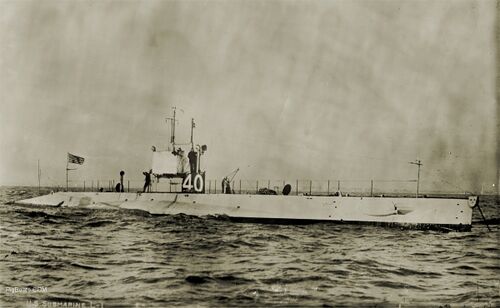
L-2 (Submarine No. 41, later SS-41)
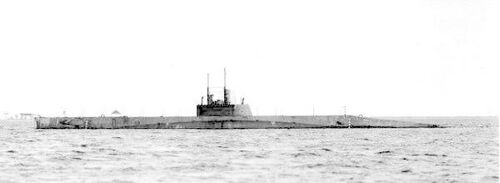
L-3 (Submarine No. 42, later SS-42)

L-4 (Submarine No. 43, later SS-43)

L-5 (Submarine No. 44, later SS-44)
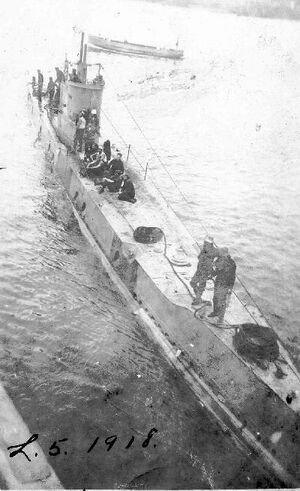
L-6 (Submarine No. 45, later SS-45)

L-7 (Submarine No. 46, later SS-46)

L-8 (Submarine No. 48, later SS-48)
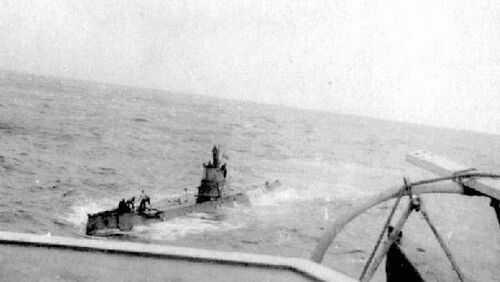
L-9 (Submarine No. 49, later SS-49)
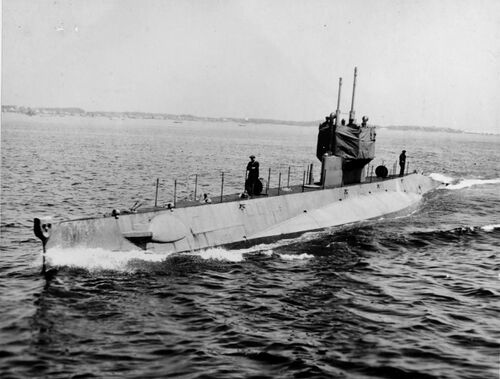
L-10 (Submarine No. 50, later SS-50)
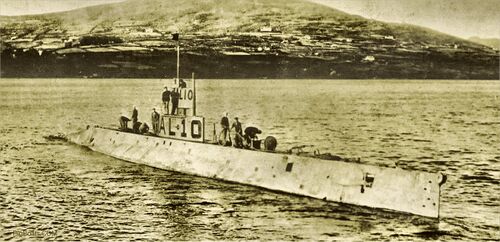
LT Vincent Arthur Clarke, Jr. was sent for submarine training at New London, Connecticut. Upon graduation he was assigned to submarine duty and sent to the Azores. From there he was made the commanding officer of the L-10, probably relieving LT Newbold T. Lawrence Jr. as CO. The L-10 operated out of Bantry Bay, Ireland for the duration of the war.
This command garnered Clarke a Navy Cross for his persistence in making the L-10 one of the "hot running boats" in WW I, racking up over 1700 hours out on patrol in pursuit of the enemy. War patrols in WW I were only an average of 10 days duration due to the sub's limits on food, water and fuel.
LT Clarke is probably the officer on the bridge in this photo as the L-10 backs away from her mooring. The crew look to be stowing the mooring lines in preparation for possibly heading out on a war patrol looking for German submarines.
L-11 (Submarine No. 51, later SS-51)
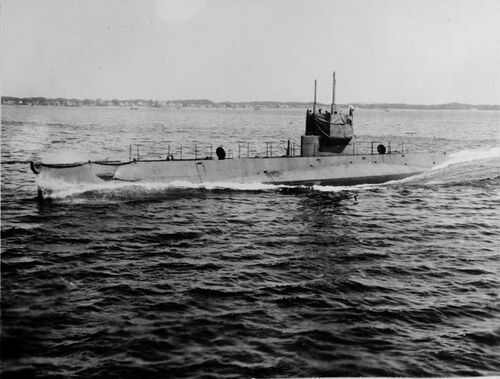
General L-class & group photos
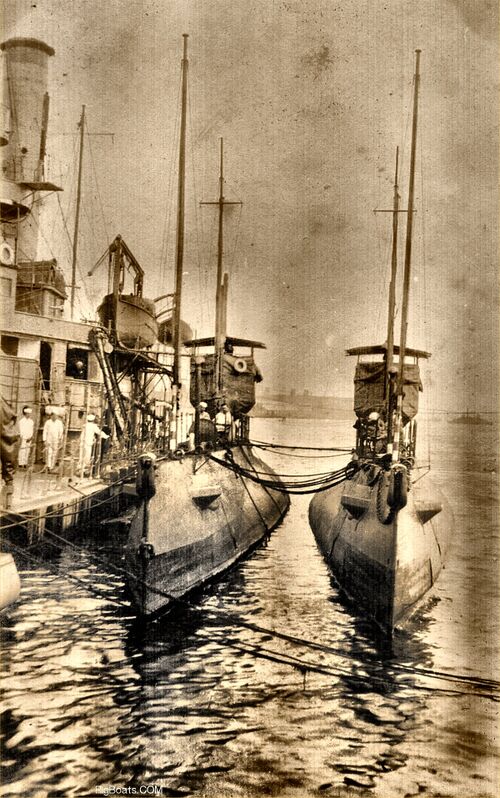
Both submarines have a tall forward radio mast. In looking in other archives we have seen only the L-1 with such a mast. So, possibly one of these two vessels could be the L-1 but it could just be coincidence that there only exists one image, other than this one, with these masts. Radio was new and trials were being made all the time.
Neither submarine have any sign of having SC tube listening gear installed at this point. So, a possible date is closer to commissioning, perhaps a late 1916 or early 1917. But for sure this is before the U.S. entered WW I on April 6, 1917. The submarines still are using the old-fashioned pre-war canvas bridge shelters that proved too flimsy to withstand the pressures of diving with it erected. They were too time consuming to try and take down in actual war time conditions.
The British, having been at war with Germany for two years, taught their American cousins a lot of practical things about actual submarine warfare including the development and use of the metal chariot bridge surround that could remain in place while diving and withstand those pressures. Soon almost all U.S. submarines had this revision installed.
Once these subs reached Europe, the British, to avoid confusing their L-class submarines with the American L-class, required the Americans to paint an "A" in front of their numbers. All combatants still wore hull identification at this time. In later conflicts all ID was painted out so an enemy could not keep track of sub movements, this is even done to this day.
These two submarines are moored to a monitor-type tender that is also not identified but could possibly be the USS Tonopah (BM-8). Three sailors are standing on the tender's deck. There also seem to be at least two people each on the submarine's decks.
Page created by:
Ric Hedman & David Johnston
1999 - 2023 - PigBoats.COM©
Mountlake Terrace, WA, Norfolk, VA
webmaster at pigboats dot com
